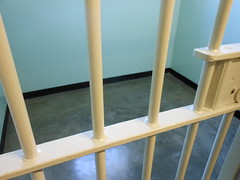 First of all we would like to thank everyone who made our signing at Warwick’s Books such a success! It means a lot to see what we do inspiring such a reaction. Thank you all!
First of all we would like to thank everyone who made our signing at Warwick’s Books such a success! It means a lot to see what we do inspiring such a reaction. Thank you all!
There seems to be a lot going on this week, and juvenile justice is taking the lead in news stories everywhere. Today, rather than focus on just one story, we would like to present a survey of the current top stories.
First stop, West Virginia.
The state’s juvenile justice system will soon be examined by a court-hired monitor, due to worries that it focuses more on punishment than rehabilitation. This is an approach that is both more expensive and less effective over time.
State Supreme Court administrative director Steve Canterbury is quoted in The Charleston Daily Mail as making a vital point on the subject:
‘I know that many citizens get very frustrated and they have the misconception that ‘rehabilitation’ means ‘mollycoddling,’ but real rehabilitation programming is stringent and demanding and at the end of the day that investment pays off in dividends because you don’t have to keep paying for the continued recidivisms of juveniles who have not been rehabilitated,’ he said.
Orlando, Florida.
In a move forward, Orlando is implementing a new program that allows cops on the street to write a ticket for many juvenile infractions that before now would have resulted in time behind bars. Geared toward “slightly troubled kids,” the option is only available to first-time offenders. Even so, the projected cost savings are sizable.
WFTV notes some of the details in their coverage of the story:
The civil citation will require things like restitution, community service and courses to correct juvenile behavior. These are much cheaper than tying up the court system, according to officials.
‘We see many, many children mess up and many of them don’t need to go deeper into the juvie justice system,’ said Secretary Wansley Walters of the Florida Department of Juvenile Justice.
Texas
The Lone Star State has taken some good strides towards a better system of juvenile justice in recent years, so it is a fitting place for nearly 700 of the nation’s top juvenile-justice reformers to gather. Such is the case this week, as some of the most engaged minds on this topic meet in Houston to share their strategies for reducing the number of troubled youths who end up incarcerated.
Bart Lubow, director of the Juvenile Justice Strategy Group at the Annie E. Casey Foundation, which is hosting the Houston gathering, says just locking kids up mostly doesn’t work.
‘Our reliance on incarceration is a failed policy. It doesn’t work for the kids; it doesn’t work for public safety; it doesn’t work for taxpayers, because it’s enormously expensive.’
New York
While advocates gather in Texas, New York is the site of a two-day conference for journalists, hosted on the campus of The John Jay College of Criminal Justice’s Center on Media, Crime and Justice. The Juvenile Justice Information Exchange is blogging it, and I highly advise checking out their coverage. Here is a little of what to expect:
While the conference, Kids Behind Bars, Where’s the Justice in America’s Juvenile Justice System?, is primarily meant for journalists, many of the topics will be of interest not only to those in the field, but the general public as well.
Speakers on Monday include: Mark Soler, executive director of the Center for Children’s Law & Policy; Vincent Schiraldi, commissioner of New York City’s Department of Probation; Ricardo Martinez, co-director, Padres & Jovenes Unidos and David Utter, director of policy, the Florida office of the Southern Poverty Law Center.
Also of note: The Crime Report is also blogging the event, if you’d like a different perspective.
California
As all know, there has been a lot of furor in The Golden State about the closure of a number of facilities dedicated to housing juvenile offenders. KALW public radio has today’s “must read,” article on the subject – an interview with one of the state’s most noted juvenile justice reformers:
Only three of California’s state facilities still remain open, holding a total of about 800 to 900 youth, and soon the state will hand down responsibility of juvenile offenders to counties. But [Barry] Krisberg, the Director of the of Research and Policy at the Chief Justice Earl Warren Institute at UC Berkeley’s School of Law, isn’t so sure that this realignment is the wisest decision. Turnstyle sat down with him to discuss the coming changes to California’s juvenile justice system and what they will mean for both the state of California and its counties.
So there you go, some of the top news on the subject of juvenile justice this week. I’m sure that as budgetary constraints get tighter and election season ramps up we will be seeing a lot more stories on the subject. We can only hope that the legislators of our nation remember that it truly is more expensive to do nothing!

























